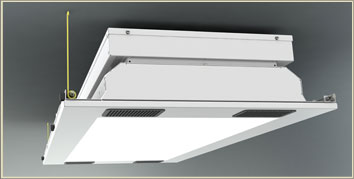Designed specifically for hospitals, nursing homes, child care centers, and other healthcare facilities where infection control is a concern, the Arcalux Health Risk Management System (HRMS) is an energy-efficient lighting fixture that doubles as a germ-killing machine.
The fixture incorporates air circulation modules, a filter, and an ultraviolet germicidal irradiation module that together pull in surrounding indoor air and eliminate up to 99% of pathogens in a single pass. The system uses differential pressure and directional airflow to isolate and kill contaminants in the fixture. It's installed in the existing electrical infrastructure with no structural, HVAC, or duct modifications.
The patented device could save lives and healthcare institutions dollars by destroying disease-causing pathogens from air and reducing hospital-acquired infections (HAI). The Centers for Disease Control estimates that $45 billion is added to the annual healthcare costs to treat HAIs. They are the fourth major cause of death with an estimated 1.7 million patients contracting an HAI, resulting in 99,000 deaths each year.
American Green Technology, Inc. (AGT) announced at Lightfair last week that it has signed a licensing agreement with Arcalux Corporation to manufacture, market, and sell Arcalux HRMS and other products from the company, through AGT's agents.
"We're excited about introducing this new product," said Danny Bogar, chief executive office of AGT. "Virtually every day you read a story about how people are dying from airborne pathogens in hospitals - a place where you normally go to regain good health. The Arcalux product addresses these health concerns."
Related Stories
| Nov 17, 2014
Mastering natural ventilation: 5 crucial lessons from design experts
By harnessing natural ventilation, Building Teams can achieve a tremendous reduction in energy use and increase in occupant comfort. Engineers from SOM offer lessons from the firm’s recent work.
| Nov 14, 2014
Bjarke Ingels unveils master plan for Smithsonian's south mall campus
The centerpiece of the proposed plan is the revitalization of the iconic Smithsonian castle.
| Nov 14, 2014
Haskell acquires FreemanWhite, strengthens healthcare design-build business
The combination expands Haskell’s geographic presence by adding FreemanWhite’s offices in Chicago, Charlotte, Nashville, and San Diego. FreemanWhite will retain its name and brand.
| Nov 14, 2014
What college students want in their living spaces
In a recent workshop with 62 college students, architects from Little explored the changing habits and preferences of today's students, and how those changes affect their living spaces.
| Nov 14, 2014
JetBlue opens Gensler-designed International Concourse at JFK
The 175,000-sf extension includes the conversion of three existing gates to international swing gates, and the addition of three new international swing gates.
Sponsored | | Nov 12, 2014
Eye-popping façade highlights renovation, addition at Chaffin Junior High School
The new distinctive main entrance accentuates the public face of the school with an aluminum tube “baguette” system.
| Nov 12, 2014
Collaboration as competitive advantage
A collaborative planning and design process may seem like a common-sense goal, but the concept can be a challenge to achieve in the fragmented AEC industry. SPONSORED BLOG
Sponsored | | Nov 12, 2014
Williams Scotsman plugs into the jobsite
Many of our customers conduct important business from their temporary modular jobsite office and most require access to technology to get their job done effectively and efficiently. SPONSORED CONTENT
| Nov 12, 2014
Chesapeake Bay Foundation completes uber-green Brock Environmental Center, targets Living Building certification
More than a decade after opening its groundbreaking Philip Merrill Environmental Center, the group is back at it with a structure designed to be net-zero water, net-zero energy, and net-zero waste.
| Nov 12, 2014
Refocusing the shifted line
A recent trend in the practice of architecture that I’ve been noticing is the blurring of responsibility between design and construction coordination. I’m not sure why this trend began, but the subject is worth exploring, writes FXFOWLE's Mark Nusbaum.

















